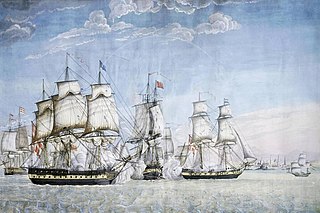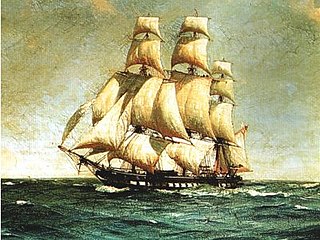Related Research Articles

The Gunboat War was a naval conflict between Denmark–Norway and Great Britain supported by Sweden during the Napoleonic Wars. The war's name is derived from the Danish tactic of employing small gunboats against the materially superior Royal Navy. In Scandinavia it is seen as the later stage of the English Wars, whose commencement is accounted as the First Battle of Copenhagen in 1801.
Five ships of the Royal Navy have been named HMS Eclair:

HMS Standard was a 64-gun Royal Navy third-rate ship of the line, launched on 8 October 1782 at Deptford. She was the last of the 15 Intrepid-class vessels, which were built to a design by John Williams.
Sixteen ships of the Royal Navy have borne the name HMS Viper, or HMS Vipere, after the members of the Viperidae family:
Clorinde was a 44-gun Uranie-class frigate of the French Navy. The Royal Navy captured her in 1803 and took her into service as HMS Clorinde. She was sold in 1817.
Sir John Lawford was an officer of the Royal Navy who served during the American War of Independence and the French Revolutionary and Napoleonic Wars.

HMS Owen Glendower was a Royal Navy 36-gun fifth-rate Apollo-class frigate launched in 1808 and disposed of in 1884. In between she was instrumental in the seizure of the Danish island of Anholt, captured prizes in the Channel during the Napoleonic Wars, sailed to the East Indies and South America, participated in the suppression of the slave trade, and served as a prison hulk in Gibraltar before she was sold in 1884.

HDMS Sarpen was a brig of the Royal Dano-Norwegian Navy, in which she served from 1791 until the British seized her in 1807. While in Dano-Norwegian service she participated in an indecisive action at Tripoli, North Africa. She served the Royal Navy as HMS Sarpen from 1808 until 1811 when she was broken up. During her brief British service she participated in the Walcheren Expedition. Her name is that of a waterfall on the Norwegian river Glomma.

The Speedy class brigs were a two-ship class of brig built for the Royal Navy during the later years of the American War of Independence. They survived into the French Revolutionary Wars.

Gracieuse was a 32-gun Charmante-class frigate of the French Navy. Renamed to Unité in 1793, she took part in the French Revolutionary Wars. The Royal Navy captured her in 1796 off Île d'Yeu and brought her into British service as HMS Unite. She was sold in 1802

Alceste was a Magicienne class frigate of the French Navy, launched in 1780, that the British seized at the Siege of Toulon. They transferred her to the Kingdom of Sardinia, but the French recaptured her a year later in the action of 8 June 1794. The British captured her again at the action of 18 June 1799 and took her into service as HMS Alceste. In 1801 she became a floating battery and she was sold the next year.
HMS Jaseur was originally the French Navy brig Jaseur that the Royal Navy captured in 1807 and took into service under the same name. She participated in one campaign and was lost in August 1808.

HMS Venus was the name ship of the 36-gun Venus-class fifth-rate frigates of the Royal Navy. She was launched in 1758 and served for more than half a century until 1809. She was reduced from 36 to 32 guns in 1792. She was sold in 1822.

HMS Boreas was a Laurel-class 22-gun post ship launched in 1806. She was wrecked off Guernsey in the Channel Islands on 28 November 1807 with the loss of most of her crew of 154 men.

HMS Delight was a British Royal Navy 16-gun brig-sloop of the Seagull class launched in June 1806, six months late. She grounded off Reggio Calabria in January 1808 and was burnt to prevent her being salvaged.
César was a mercantile brig launched in 1802 that the French Navy purchased at Bordeaux in 1803. The Royal Navy captured her in July 1806 and took her into their service, but she was wrecked in early 1807.
Friedland was the name-ship of her class of French Illyrien or Friedland-class brig. She was built at Venice and launched in June 1807. The Royal Navy captured her a year later and took her into service as HMS Delight. She served in the Mediterranean and was sold in 1814.
HMS Autumn was launched at Shields in 1800 as a merchantman. The Royal Navy purchased her in 1801. The Navy sold her in 1815 and she returned to mercantile service. She was lost in 1818.
HMS Nonpareil was launched at Baltimore in 1801 or 1807. The Navy captured her in 1808 and purchased her. Nonpareil captured a French naval brig in a severe action in 1810. The Navy sold Nonpareil in 1813 after a storm damaged her.
HMS Avenger was the collier Thames, launched in 1803, that the Royal Navy purchased in 1804 and renamed. During her service she captured a number of prizes. She also captured one French privateer and participated in the capture of the Danish island of Anholt. She wrecked at St. John's, Newfoundland on 8 October 1812.
References
- ↑ British Warships in the Age of Sail 1793 1817: Design, Construction, Careers and Fates Rif Winfield 2014
- ↑ "Captain George Manby". Archived from the original on 4 August 2017. Retrieved 3 August 2017.
- ↑ Annex, in The Weathermen: Their Story, Gordon Tripp 2017
- ↑ "No. 16260". The London Gazette . 23 May 1809. p. 736.
- ↑ British Warships in the Age of Sail 1793 1817: Design, Construction, Careers and Fates Rif Winfield 2014